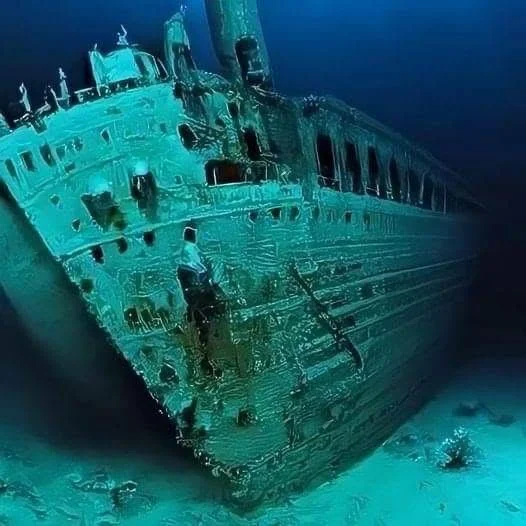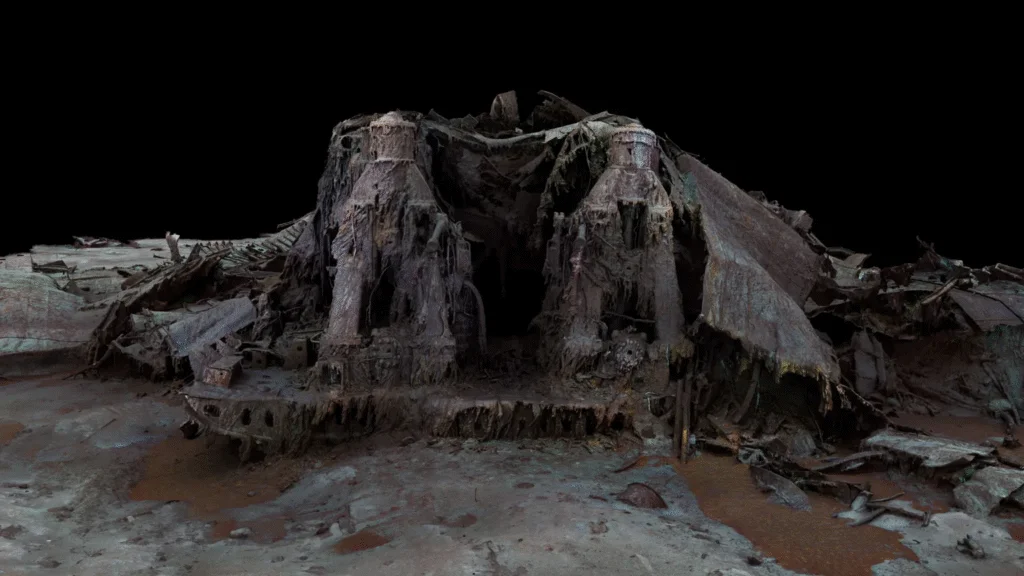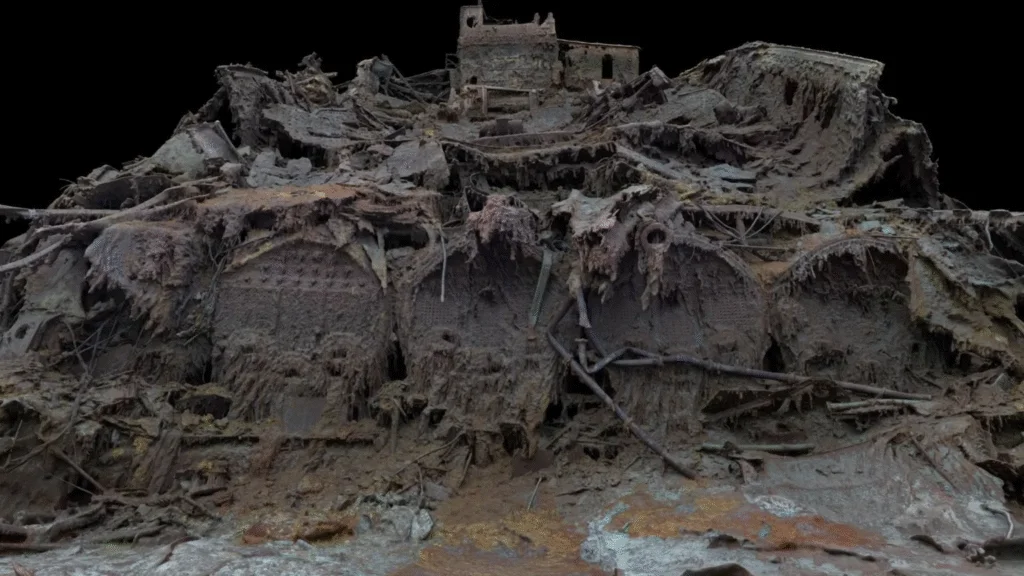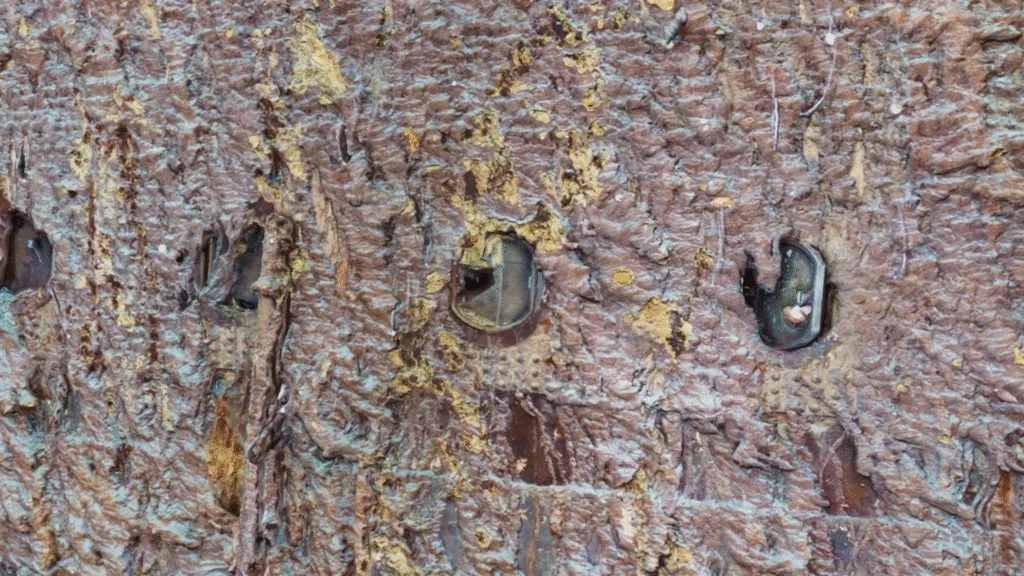It’s been over 110 years since the Titanic slipped beneath the Atlantic, but it’s still not done speaking. Thanks to cutting-edge technology, a new full-scale 3D scan of the iconic shipwreck is giving us the clearest view yet—revealing heartbreak, heroism, and hard truths that have been buried deep beneath the sea for generations.
This isn’t just another deep-sea dive or grainy photo. It’s a digital time machine. For the first time ever, researchers can study the Titanic in perfect detail—from bow to stern—without even dipping a toe in the ocean. And what they’re uncovering is as fascinating as it is sobering.

The First Complete Look at Titanic—From Every Angle
The Titanic lies more than two miles beneath the surface, in a world of cold, crushing pressure. Previous expeditions could only gather snapshots—sections of twisted steel and collapsed decks—but they never saw the whole picture.
That changed in 2023, when over 700,000 high-resolution images were stitched together to create a full digital twin of the ship. Using underwater drones and advanced mapping tech, researchers captured everything—every bolt, crack, and collapsed corridor.
This wasn’t just a cool science experiment. It became the centerpiece of a new documentary, Titanic: The Digital Resurrection, created by National Geographic and Atlantic Productions. And now, the wreck is being seen in a whole new light.
Video: New Titanic scan reveals ground-breaking details of ship’s final hours
The Breakup That Changed History
One of the scan’s most haunting features is the sheer brutality of how Titanic broke apart. The bow, still eerily upright, looks frozen in time—silent and solemn. But the stern? It’s chaos. A tangled heap of steel, engines, and twisted decks that shows just how violently the ship was ripped in two.
Huge engines lie exposed like fallen giants, surrounded by snapped pipes and caved-in floors. What once powered the largest ship on Earth now rests lifeless, buried in silence and rust.
For historians, it’s not just about the drama. It’s about evidence—proof of how the ship went down and what really happened in those final, frantic moments.
The Heroes in the Heat: Engineering Team’s Final Stand

One of the scan’s most touching discoveries lies in the ship’s heart—its boiler rooms. For years, survivor stories talked about lights staying on as Titanic sank. People wondered how. Now, we may have our answer.
The scan shows a preserved boiler room and an open steam valve. This tiny detail—one piece of metal captured in just the right position—suggests the engineering crew kept power flowing until the very last moment.
That open valve? It might be one of the most powerful symbols of bravery ever seen. These men didn’t run. They stayed behind so lifeboats could be lowered in light instead of darkness. That small act likely saved lives.
A Series of Small Holes—Not One Giant Tear

Forget the Hollywood version of a giant gash. According to a new simulation based on the scan and Titanic’s original blueprints, the real damage came from a string of small punctures.
These narrow tears—each about the size of a sheet of paper—ran along six watertight compartments. The ship was designed to stay afloat with four breached. But six? That doomed her.
It wasn’t a single, dramatic blow. It was slow, silent flooding—a creeping catastrophe that quietly overwhelmed the ship’s defenses. Like water slipping through cracks in a dam, the end came not with an explosion, but a rising tide.
Small Details, Big Impact: Seeing the Ship Like Never Before
Video: Scan of Titanic wreck reveals new insight into ship’ final hours
What makes this scan truly mind-blowing is the tiny details it captures. We’re talking intact portholes, shattered glass, lifeboat equipment still in place, and deck cranes frozen in mid-duty.
Some portholes even still hold their original glass. Others show damage consistent with survivor accounts of ice bursting through during the collision.
The ship’s structure, covered in rust-colored “rusticles,” has an almost organic look—like the wreck itself is alive, slowly transforming into something new. A forgotten palace at the bottom of the sea.
Not Just a Shipwreck—A Silent Crime Scene
To Titanic historian Parks Stephenson, the scan is more than historical documentation. It’s a crime scene. A massive, silent one frozen in time.
Scattered across the debris field are shoes, teacups, luggage, and other haunting personal items. Each one tells a story. A missed goodbye. A life interrupted. A dream that never made it to New York.
The ship may be corroded and broken, but the human side? It’s impossible to ignore. This isn’t just about steel and rivets—it’s about people.
Secrets in the Shadows: What Titanic Still Isn’t Saying

Even with all this data, the Titanic holds onto some of her secrets. Some parts remain buried in silt, others too mangled to fully understand. But each new scan, each frame of this digital model, adds another piece to the puzzle.
We’re not just reconstructing a ship. We’re rediscovering a moment frozen in time. A moment that shaped history, changed safety laws, and still echoes in our cultural memory more than a century later.
Conclusion: A Window into Tragedy, Courage, and Truth
This 3D model isn’t just cool tech. It’s a bridge between the past and the present. It brings us closer than ever to understanding the Titanic—not just how it sank, but what that night truly meant.
From the engineers who stood their ground to the passengers who watched the lights flicker above the waves, every detail matters. And now, for the first time, we can see it all. Not just the wreckage—but the resilience. Not just a tragedy—but a human story still unfolding, one scan at a time.
The Titanic may rest on the ocean floor, but her story is far from buried. And thanks to technology, she’s finally telling it in full.


